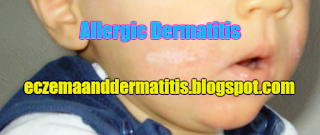Allergic dermatitis is a condition that affects as many as a third of all children in the United States alone. This is a skin complaint that in most cases goes away eventually as young sufferers get older, but for some it sadly becomes something that stays with them through their entire lives.
Atopic dermatitis, which is another name for allergic dermatitis, typically shows itself in infant children around the age of six to twelve weeks. The condition is characterised by a sensation of itching, the most obvious response to which is to scratch the affected area. It is this persistent scratching, in response to the problem of itching, which leads to the red rashes that can be seen on the faces and elsewhere on the bodies of sufferers from the syndrome.
When the problem of allergic dermatitis deepens, additional symptoms may be seen. These include the following: a darkening of the skin of the eyelids, and the appearance there of an extra fold of skin, known as the “Dennie-Morgan fold”; a phenomenon known as lichenification, which describes a thickening and hardening of the skin so that it resembles leather; the development of raised papules on the skin, which can become infected; the appearance of other red marks, called hives, on the skin in response to allergic reactions.
All the symptoms described above can be immensely disturbing to young children. The condition can cause chronic sleeplessness, as the tendency to scratch takes over from the need to sleep.
The sites of specific symptoms of atopic dermatitis may shift around from one place on the body to another, but the problem as a whole never seem to go away, at least not until children get a bit older. At any one time, red papules may appear on patients’ elbows, necks, knees, ankles, wrists, and hands. Another problem area can be the lips, where the tendency to try to relieve the irritation by licking can lead to the lips becoming painfully chapped.
Luckily, many victims of allergic dermatitis see their troubles fade as they get older, typically after the age of about eighteen months. However, sufferers may become prone to eczema later in life.
The causes, as opposed to the triggers, of allergic or atopic dermatitis are not known. It appears to involve a genetic predisposition to the condition; in other words, this type of dermatitis, which mostly affects young children, seems to run in families.
Although the ultimate cause of atopic dermatitis may not be known, what IS known is that there are many factors that have been shown to trigger the complaint. These include things like cigarette smoke, household and other dust, clothing fibers (both natural and synthetic), some soaps and cleaning products, also perfume products and other cosmetics. In addition, individuals may have a particular reaction to certain foods such as fish, milk, cheese, eggs, and wheat-based products, as well as substances like pollen and mold.
When you have a child that develops allergic dermatitis, you are strongly advised to look closely at what might be the possible triggers, and where possible reduce or eliminate the patient’s exposure to these things.
Source: stasisdermatitis.net/allergic-dermatitis/
Atopic dermatitis, which is another name for allergic dermatitis, typically shows itself in infant children around the age of six to twelve weeks. The condition is characterised by a sensation of itching, the most obvious response to which is to scratch the affected area. It is this persistent scratching, in response to the problem of itching, which leads to the red rashes that can be seen on the faces and elsewhere on the bodies of sufferers from the syndrome.
When the problem of allergic dermatitis deepens, additional symptoms may be seen. These include the following: a darkening of the skin of the eyelids, and the appearance there of an extra fold of skin, known as the “Dennie-Morgan fold”; a phenomenon known as lichenification, which describes a thickening and hardening of the skin so that it resembles leather; the development of raised papules on the skin, which can become infected; the appearance of other red marks, called hives, on the skin in response to allergic reactions.
All the symptoms described above can be immensely disturbing to young children. The condition can cause chronic sleeplessness, as the tendency to scratch takes over from the need to sleep.
The sites of specific symptoms of atopic dermatitis may shift around from one place on the body to another, but the problem as a whole never seem to go away, at least not until children get a bit older. At any one time, red papules may appear on patients’ elbows, necks, knees, ankles, wrists, and hands. Another problem area can be the lips, where the tendency to try to relieve the irritation by licking can lead to the lips becoming painfully chapped.
Luckily, many victims of allergic dermatitis see their troubles fade as they get older, typically after the age of about eighteen months. However, sufferers may become prone to eczema later in life.
The causes, as opposed to the triggers, of allergic or atopic dermatitis are not known. It appears to involve a genetic predisposition to the condition; in other words, this type of dermatitis, which mostly affects young children, seems to run in families.
Although the ultimate cause of atopic dermatitis may not be known, what IS known is that there are many factors that have been shown to trigger the complaint. These include things like cigarette smoke, household and other dust, clothing fibers (both natural and synthetic), some soaps and cleaning products, also perfume products and other cosmetics. In addition, individuals may have a particular reaction to certain foods such as fish, milk, cheese, eggs, and wheat-based products, as well as substances like pollen and mold.
When you have a child that develops allergic dermatitis, you are strongly advised to look closely at what might be the possible triggers, and where possible reduce or eliminate the patient’s exposure to these things.
Source: stasisdermatitis.net/allergic-dermatitis/







0 Comments:
Post a Comment